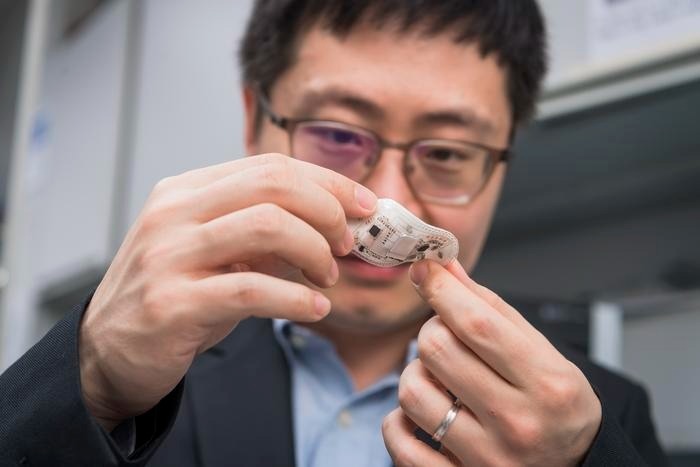Scientists at the City University of Hong Kong (CityUHK) have created wearable electronics that are lightweight, stretchable, and have a 400-fold increase in sweat permeability. This allows for the accurate long-term monitoring of biosignals for biomedical devices.

The permeable wearable electronics developed by the team for long-term biosignal monitoring. Image Credit: City University of Hong Kong
The research team, led by Professor Yu Xinge of CityUHK’s Department of Biomedical Engineering (BME), has recently solved the most important problem facing wearable biomedical devices by developing a universal process to create these super wearable electronics that allow gas and sweat permeability.
Wearable electronics play a key part in promoting health and fitness. Continuous monitoring of physiological signals over a prolonged period is essential for gaining a comprehensive perspective on an individual's overall health status, early disease prediction, personalized therapeutics and improved management of chronic health conditions.
Sweat or air permeability, however, might have an impact on the long-term signal stability. Professor Yu and his team have dedicated considerable effort to addressing the demand for wearable devices capable of offering continuous and stable monitoring of vital signs without causing discomfort or signal disruption due to perspiration.
Addressing this challenge, the team has crafted a foundational approach that spans materials processing, device architecture, and system integration. This approach underpins the development of integrated permeable wearable electronics, leveraging a nature-inspired three-dimensional liquid diode (3D LD) configuration. In this setup, surface structures are engineered to naturally guide the flow of liquids in a predetermined direction.
The results were recently published in the esteemed journal Nature.
Incorporating a 3D spatial liquid manipulation technique, we have achieved fully integrated permeable electronics that match the circuitry and functionality to state-of-the-art wearable devices, enabling superb breathability. The 3D LD does not rely on unique materials but adopts an in-plane liquid transport layer called the horizontal liquid diode.
Yu Xinge, Professor and Study Corresponding Author, Department of Biomedical Engineering, City University of Hong Kong
The device developed in the study boasts an impressive capability to transport sweat away from the skin, outperforming the human body's own sweat production rate by 4,000 times. This advancement ensures uninterrupted monitoring, even in conditions that induce sweating, addressing the problem of signal interference due to sweat accumulation at the device-skin interface.
Furthermore, the device's design—thin, lightweight, soft, and stretchable—ensures it integrates seamlessly with the human body. It adheres effectively to the skin, maintaining a comfortable and stable connection, which results in the transmission of high-quality signals.
Our findings provide fluid manipulation and system integration strategies for the soft, permeable wearables. We have successfully applied this technology to both advanced skin-integrated electronics and textile-integrated electronics, achieving reliable health monitoring over a weeklong duration.
Yu Xinge, Professor and Study Corresponding Author, Department of Biomedical Engineering, City University of Hong Kong
The team is now moving its attention towards clinical trials to confirm the effectiveness of their technology in real-world scenarios.
The corresponding author is Professor Yu. The paper’s first authors are Drs. Zhang Binbin, Li Jiyu, Zhou Jingkun, and Chow Lung. As postdoctoral fellows in the BME and Hong Kong Center for Cerebro-Cardiovascular Health Engineering, two InnoHK centers, are Drs. Zhang and Li. Professor Yu is the advisor for Mr. Zhou Jingkun and Mr. Chow, who are Ph.D. candidates.
Journal Reference:
Zhang, B., et al. (2024) A three-dimensional liquid diode for soft, integrated permeable electronics. Nature. doi.org/10.1038/s41586-024-07161-1